Prysmian Bundle
How Does Prysmian Group Power the Future?
Prysmian Group, a titan in the energy and telecom cable systems sector, is at the forefront of the global energy transition and digital revolution. Its recent Q1 2025 results, showcasing a 5.0% organic revenue growth, highlight its significant impact on worldwide infrastructure. With a rich history and a vast global footprint, understanding Prysmian SWOT Analysis is key to grasping its strategic positioning.
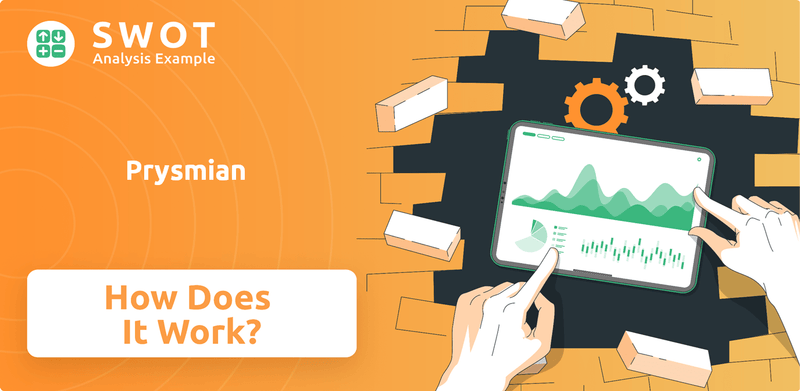
This deep dive into Prysmian Company will explore its core Prysmian operations, from cable manufacturing to fiber optic cables, and its crucial role in energy infrastructure. We'll examine its financial performance, global presence, and sustainability initiatives, providing insights into how Prysmian is shaping the future. Explore the company's product range, its impact on renewable energy, and its data transmission solutions to understand its competitive advantages and future outlook.
What Are the Key Operations Driving Prysmian’s Success?
The Prysmian Group is a global leader in the design, production, and installation of cables and systems for energy and telecommunications. Prysmian operations are organized into three main segments: Projects, Energy Products, and Telecom. These segments allow the company to focus on specific markets and customer needs, ensuring efficient operations and targeted product development.
The company's core business involves the manufacturing and supply of a wide range of cables, including power transmission, distribution, and fiber optic cables. Prysmian Company focuses on technological innovation, sustainability, and global presence to deliver value to its customers. This includes a strong emphasis on sustainable practices throughout its operations and supply chain.
A key aspect of Prysmian Group's value proposition is its ability to provide advanced, reliable, and sustainable cable solutions. These solutions are crucial for the energy transition and digital transformation, supporting the growth of renewable energy and high-speed data transmission. The company’s commitment to innovation and sustainability helps it maintain a competitive edge in the market.
Prysmian operates extensive manufacturing facilities globally to produce a wide range of cables. The supply chain is diversified, with a strong presence in Europe, North America, Latin America, and Asia-Pacific. In 2024, the company initiated a renovation of its Vendor Management portal to enhance supplier assessment processes, focusing on risk management and promoting sustainable practices.
Prysmian invests significantly in research and development, particularly in high voltage (HV) and extra high voltage (EHV) cable markets. This investment supports the development of advanced cable solutions that meet the evolving needs of the energy and telecom sectors. The company’s innovation is a key driver of its competitive advantage.
Sustainability is a core focus, with initiatives to increase recycled content in products and strengthen procurement processes. The company is committed to reducing its environmental impact and promoting sustainable practices throughout its operations. This includes efforts to source materials responsibly and minimize waste.
Prysmian's advanced cable solutions enable the energy transition and digital transformation, providing reliable and efficient infrastructure. The company's focus on innovation and sustainability translates into benefits for customers, including improved performance and reduced environmental impact. The company's offerings are essential for modernizing energy grids and expanding data networks.
The Prysmian operations are characterized by a global footprint, technological leadership, and a strong commitment to sustainability. This enables the company to meet the growing demand for advanced cable solutions. The company's focus on efficiency and innovation drives its success in the market.
- Manufacturing: Extensive global manufacturing facilities.
- Sourcing: Procurement of raw materials, including copper and other components.
- Technology: Continuous R&D in HV and EHV cables.
- Logistics: Efficient global distribution and installation services.
- Sales: Direct sales and partnerships with distributors.
- Customer Service: Comprehensive support and maintenance.
For further insights into the company's strategic positioning, consider reading about the Target Market of Prysmian.
Prysmian SWOT Analysis
- Complete SWOT Breakdown
- Fully Customizable
- Editable in Excel & Word
- Professional Formatting
- Investor-Ready Format
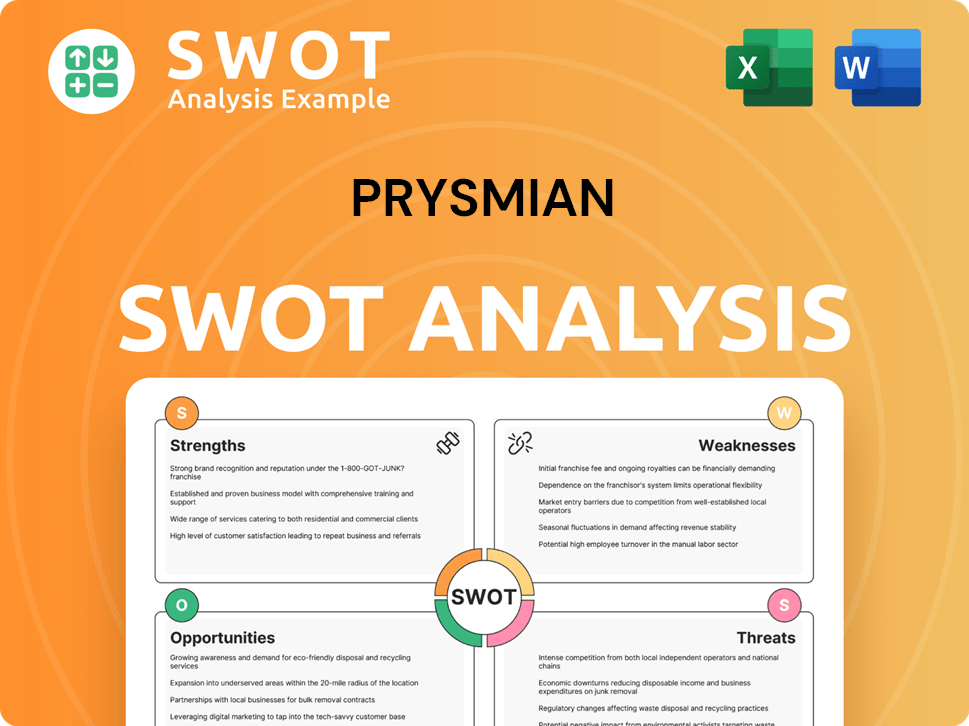
How Does Prysmian Make Money?
The Prysmian Group primarily generates revenue through the sale and installation of cables and systems. These products serve the energy and telecom sectors. In 2024, the company's revenue reached €17.0 billion, marking a 10.9% year-over-year increase.
For the first quarter of 2025, the company's revenues were €4,771 million, up from €3,687 million in Q1 2024, representing a 5.0% organic growth. The company's monetization strategies involve offering solutions beyond just cable manufacturing.
The company aims to increase 'new product vitality' to 30% by 2028, indicating a focus on innovative offerings. Pricing strategies include passing through metal price inflation to clients. The acquisition of Encore Wire in 2024 is expected to enhance revenue and profitability in the electrification segment, with estimated EBITDA synergies of €140 million by 2026. Further strengthening its position is the acquisition of Channell Commercial Corporation, expected to close in Q2 2025, which will boost its Digital Solutions business, particularly in North America.
The main revenue stream for Prysmian Company comes from the sale and installation of cables and systems. These are used in the energy and telecom sectors. The company's focus on providing comprehensive solutions drives its revenue model.
Monetization strategies include offering sustainable solutions and innovative products. Pricing strategies involve passing on metal price inflation. Acquisitions, like Encore Wire and Channell Commercial Corporation, boost revenue and profitability.
Different segments, such as Transmission, Power Grid, Electrification, and Digital Solutions, have varying growth rates. Transmission showed a 57.2% organic growth in Q1 2025. Digital Solutions also contributed positively with a 3.4% organic growth in Q1 2025.
Revenues from sustainable solutions constituted 43% of total revenue in 2024. The company aims to increase this to over 55% by 2028. This focus highlights Prysmian Group's commitment to sustainable practices.
The company aims to increase 'new product vitality' to 30% by 2028. This indicates a strong emphasis on innovation and introducing new offerings. This is a key aspect of Prysmian operations.
The acquisition of Encore Wire is expected to boost the electrification segment. The Channell Commercial Corporation acquisition will strengthen Digital Solutions, particularly in North America. These acquisitions support Prysmian's growth strategy.
The Prysmian Group's financial performance shows strong growth, driven by strategic initiatives and market demand. Understanding the company's financial health is crucial for investors. For more insights, check out the Brief History of Prysmian.
- In Q1 2025, Transmission segment revenues grew to €743 million from €474 million in Q1 2024.
- The acquisition of Encore Wire is expected to generate EBITDA synergies of €140 million by 2026.
- Sustainable solutions accounted for 43% of total revenue in 2024, with a target to exceed 55% by 2028.
- The Digital Solutions business is being strengthened through acquisitions like Channell Commercial Corporation.
Prysmian PESTLE Analysis
- Covers All 6 PESTLE Categories
- No Research Needed – Save Hours of Work
- Built by Experts, Trusted by Consultants
- Instant Download, Ready to Use
- 100% Editable, Fully Customizable
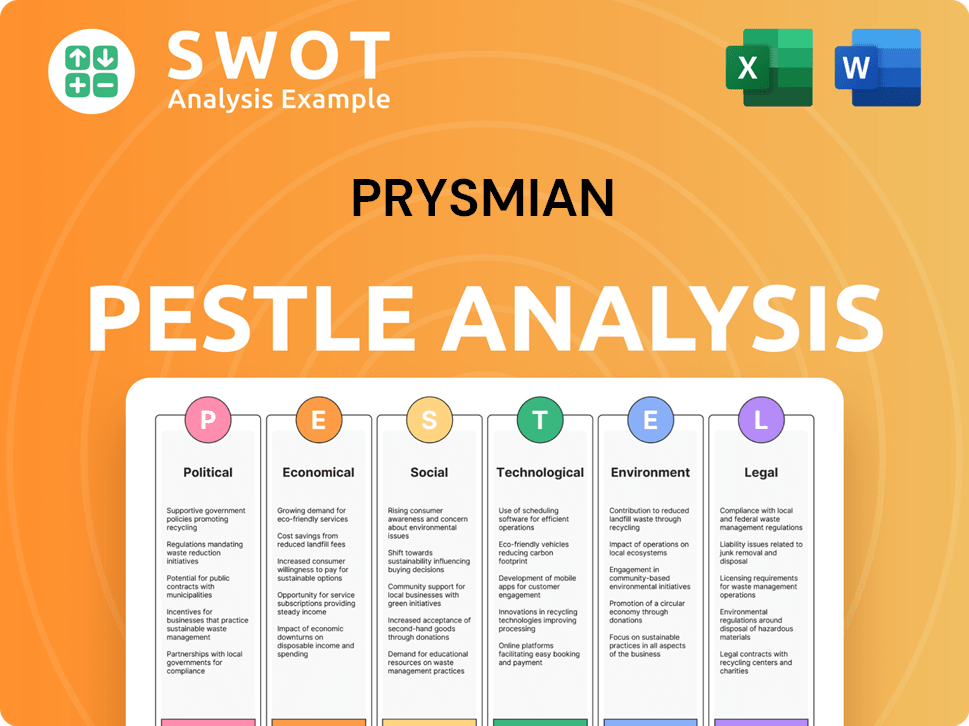
Which Strategic Decisions Have Shaped Prysmian’s Business Model?
The Prysmian Group, a global leader in the cable industry, has a history marked by strategic acquisitions and a focus on expanding its market presence. Key milestones include significant acquisitions that have reshaped its operations and competitive landscape. These moves have not only broadened its product offerings but also strengthened its position in key markets.
Strategic initiatives have been central to Prysmian operations, driving growth and enhancing its capabilities. The company has consistently invested in research and development, new technologies, and sustainable solutions. These investments are designed to meet evolving market demands and support its long-term growth strategy. The company's focus on sustainability is also reflected in its accelerated Net Zero target.
The company's competitive edge stems from its technological leadership, global presence, and commitment to innovation. Prysmian Company leverages its extensive manufacturing footprint and diversified product portfolio to serve a wide range of industries. Its focus on sustainable solutions and its commitment to reducing its environmental impact further strengthen its market position.
A major milestone was the acquisition of General Cable in 2018 for approximately $3 billion, which expanded its presence in the Americas. This acquisition increased net financial debt to €2,222 million by the end of 2018. In 2024, Prysmian announced the acquisition of Encore Wire Corp. for approximately $4.2 billion (€3.9 billion), further solidifying its position in the U.S. cable market.
The integration with General Cable generated higher-than-expected synergies, revised upwards to €175 million to be achieved by 2021. The Encore Wire Corp. acquisition, completed in July 2024, is expected to boost cash generation and deleveraging in 2025 and 2026. Another strategic move is the acquisition of Channell Commercial Corporation in 2025, aimed at enhancing its Digital Solutions business in North America.
Prysmian's global leadership and strong brand recognition provide a significant advantage. Technological leadership in high voltage and extra high voltage cables, supported by substantial R&D investments (€105 million in 2018), is crucial. The company benefits from economies of scale, a broad manufacturing base with 107 plants, and a diversified product portfolio.
Prysmian is adapting to new trends by accelerating its Net Zero target to 2035 from 2050. It aims for over 55% of revenues from sustainable solutions by 2028. The company's flexible supply chain and global presence enable efficient delivery and lower logistics costs. For more insights, you can explore the Marketing Strategy of Prysmian.
Prysmian's competitive advantages are rooted in its global leadership position and strong brand recognition. Its technological leadership in high voltage and extra high voltage cables is supported by significant R&D investments. The company's extensive manufacturing footprint and diversified product portfolio also contribute to its success.
- Global Leadership: Strong market presence and brand recognition.
- Technological Leadership: Innovation in high and extra high voltage cables.
- Extensive Manufacturing: A network of 107 plants worldwide.
- Sustainability Initiatives: Aiming for over 55% of revenues from sustainable solutions by 2028.
Prysmian Business Model Canvas
- Complete 9-Block Business Model Canvas
- Effortlessly Communicate Your Business Strategy
- Investor-Ready BMC Format
- 100% Editable and Customizable
- Clear and Structured Layout
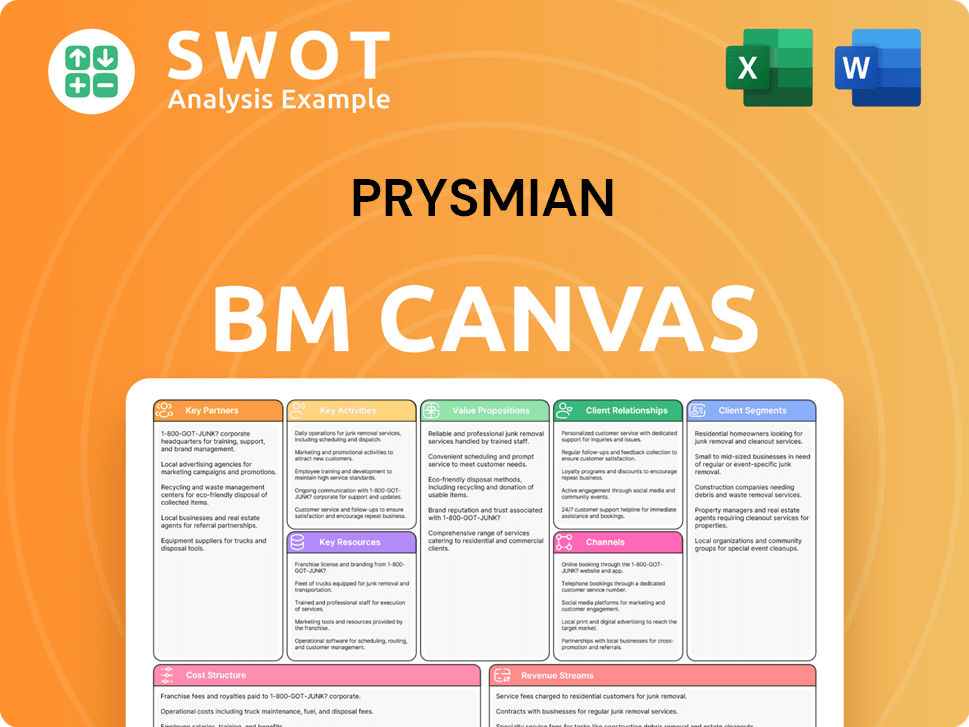
How Is Prysmian Positioning Itself for Continued Success?
The Prysmian Group holds a leading position in the global cable manufacturing industry. As of May 7, 2025, the company's market capitalization was €14.5 billion. Prysmian's ability to maintain a flexible supply chain and implement effective cost pass-through mechanisms has contributed to its strong financial performance.
However, Prysmian faces risks such as intense competition and geopolitical factors. The recent acquisition of Encore Wire has increased the company's debt, necessitating a focus on deleveraging. Despite these challenges, Prysmian is well-positioned to benefit from the growth in energy transition and digitalization.
Prysmian Group is a global leader in the fragmented cable manufacturing sector. It has strong market positions in key regions, including Europe, the Middle East, Africa (EMEA), the U.S., and Latin America. The company's diverse geographical presence supports its overall market strength.
Key risks include intense competition, especially in lower value-added activities. Subdued demand in certain segments and execution risks on large projects also pose challenges. Geopolitical factors, such as potential U.S. tariffs, could negatively impact operations.
Prysmian is strategically positioned to capitalize on the energy transition and digitalization trends. The company has confirmed its 2025 guidance, targeting an adjusted EBITDA of €2,250-€2,350 million and free cash flow of €950-€1,050 million.
The company's adjusted EBITDA margin was 11.3% in 2024 and 13.1% in Q1 2025. Prysmian aims for an adjusted EBITDA of €2.95 billion to €3.15 billion by 2028. Cumulative capital expenditure is planned at €2.6 billion between 2025 and 2028.
Prysmian is focusing on sustainable solutions and financial health. The company plans to increase the share of revenues from sustainable solutions to over 55% by 2028. It is also committed to achieving Net Zero by 2035, accelerating its original 2050 target.
- Strengthening the balance sheet through cash flow generation.
- Reducing debt to achieve a net debt to EBITDA ratio between 1.0x and 1.5x.
- Investing in the Transmission business, which will be the primary focus of capital expenditure.
- Expanding its product range to meet the growing demand for fiber optic cables and data transmission solutions.
Prysmian Porter's Five Forces Analysis
- Covers All 5 Competitive Forces in Detail
- Structured for Consultants, Students, and Founders
- 100% Editable in Microsoft Word & Excel
- Instant Digital Download – Use Immediately
- Compatible with Mac & PC – Fully Unlocked
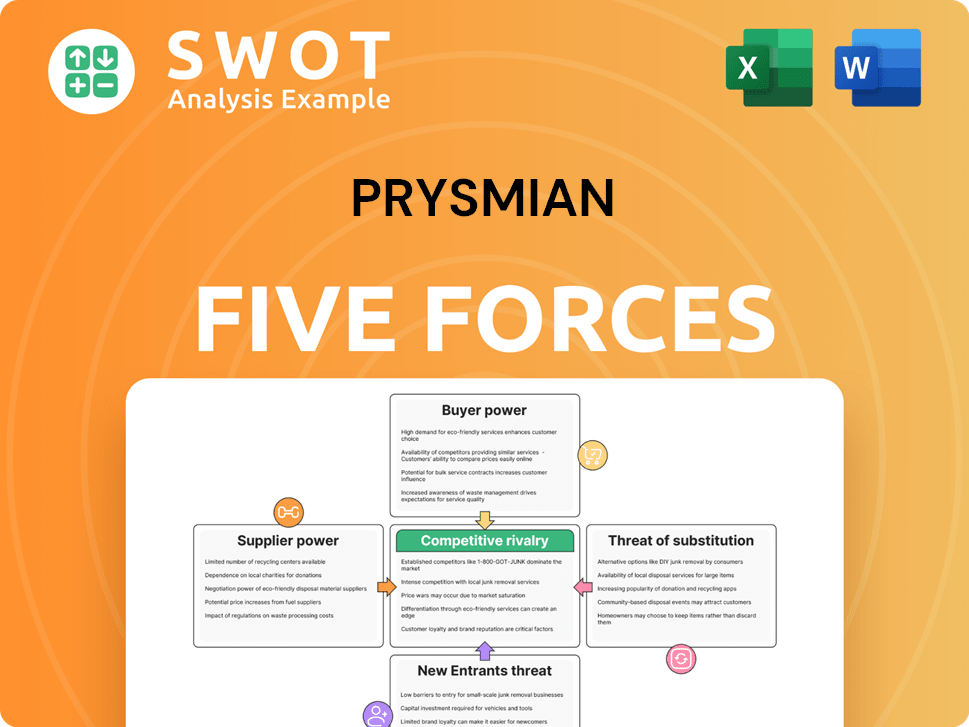
Related Blogs
- What are Mission Vision & Core Values of Prysmian Company?
- What is Competitive Landscape of Prysmian Company?
- What is Growth Strategy and Future Prospects of Prysmian Company?
- What is Sales and Marketing Strategy of Prysmian Company?
- What is Brief History of Prysmian Company?
- Who Owns Prysmian Company?
- What is Customer Demographics and Target Market of Prysmian Company?
Disclaimer
All information, articles, and product details provided on this website are for general informational and educational purposes only. We do not claim any ownership over, nor do we intend to infringe upon, any trademarks, copyrights, logos, brand names, or other intellectual property mentioned or depicted on this site. Such intellectual property remains the property of its respective owners, and any references here are made solely for identification or informational purposes, without implying any affiliation, endorsement, or partnership.
We make no representations or warranties, express or implied, regarding the accuracy, completeness, or suitability of any content or products presented. Nothing on this website should be construed as legal, tax, investment, financial, medical, or other professional advice. In addition, no part of this site—including articles or product references—constitutes a solicitation, recommendation, endorsement, advertisement, or offer to buy or sell any securities, franchises, or other financial instruments, particularly in jurisdictions where such activity would be unlawful.
All content is of a general nature and may not address the specific circumstances of any individual or entity. It is not a substitute for professional advice or services. Any actions you take based on the information provided here are strictly at your own risk. You accept full responsibility for any decisions or outcomes arising from your use of this website and agree to release us from any liability in connection with your use of, or reliance upon, the content or products found herein.